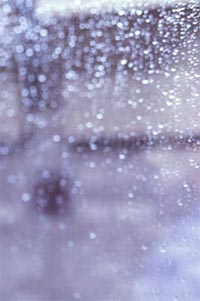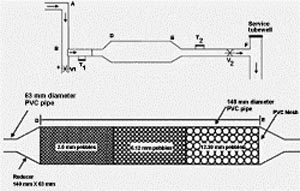Dec 24, 2025
Dec 24, 2025
Filters As a further safeguard a variety of filters are used to prevent silt or any other contaminant from entering the harvesting structure. One has to select a filter according to his budget and requirement. For example, water from a thatched sloping roof may contain more of coarser contaminants that from the flat RCC roof. But the later is common in urban areas where the atmosphere is more polluted and a refined filter may be necessary. A simple filter can be made from a drum or an earthen pot with layers of gravel, charcoal and sand. All these are easily available anywhere. Sand filters are excellent for removing turbidity and micro-organisms and they are cheap too. While choosing a filter one has to take in to account the hydro-meteorological, geo-hydrological and geological conditions into account. The filter has to cope up with the intensity of rain as well. For larger rooftops a filter with concentric chambers is used. Finally water reaches the harvesting structure through the innermost chamber filled with pebbles. Using a 90 liter High Density Poly Ethylene (HDPE) drum, S. Viswanath a rainwater harvesting expert from Bangalore devised a filter (named Rain Barrel) which suits the average rainfall of Bangalore. Costing about Rs 2250 this filter has a sponge lid at the inlet point. This ensures filtration of finer particles in water and is easy to clean. As rainwater harvesting is becoming the in thing, even private filter manufacturers have jumped into the fray and a large variety is available in the market to suit ones pocket and need. Storage of Water Many times the harvested water has to be stored for long periods. This is more so in Hilly terrains and hard rock areas. Precautions for maintaining cleanliness are essential in such conditions. All kinds of turbidity and smells are taken care of by sand filters. Bacteria need special treatment. Chlorination of stored water is a must. One gram of bleaching powder is enough to treat 200 liters of water. Therefore appropriate measured quantities of bleaching powder may be used. As an alternative, water drawn from the storage tank can be boiled for 20 minutes to remove all biological contaminants. Smaller quantities of water can be effectively treated using solar disinfection method, commonly known as SODIS. Water stored in plastic bottles is placed in the Sun light for six hours. The Ultraviolet Rays of the Sun take care of all the micro-organisms. In case the Sun light is poor, the bottles can be half blackened along the length. This enhances the heat within the bottle. Bottles should be filled only three fourth. The oxygen present within the bottle combined with Sun's radiation treats water more effectively. For SODIS treatment water should be free from turbidity. Hazardous Areas It has been repeatedly said in these articles that rainwater harvesting techniques depend upon geology, geo-hydrology and hydro-meteorology of the area. For a lay man it is not possible to be proficient with all these factors. Yet there are certain factors that are easy to understand. For example in canal irrigated areas water-logging is rampant, because water of the unlined canal seeps in and gradually raises the water table till the surroundings are water-logged. Therefore rainwater harvesting in flood prone areas should not be done. In Industrial areas discharge of effluents into nearby ponds and lakes is rampant in India. Such water bodies should never be used as harvesting structures or even recharged with a bore well. While recharging an abandoned dug well, it should first be thoroughly cleaned then filled with graded layers of pebbles, coarse and fine sand from bottom to top up to a depth of three meters. This acts as a natural filter. The behavior of the aquifer is governed by several parameters which are beyond the comprehension of a lay man. Along a river at some places the aquifer feeds the river and at others draws water from the river. In case of a house or a multistoried complex on the riverside the residents must seek expert advice before investing money on rainwater harvesting. In case the aquifer is of the former type, all the water harvested by them will flow down to river. Identification of such areas is systematically carried out by the Central Ground Water Board (CGWB). The depth of the recharge well in alluvium terrains should be within the normal zone of groundwater extraction. The aquifer should be minimum five to ten meters or more thick. Naturally one needs expert advice to identify these conditions. Rainwater harvesting and artificial recharge are the only techniques that can save the society from water scarcity. Population pressure, change in rainfall patterns, deforestation misuse of natural harvesting structures like lakes and ponds etc are leading to a serious situation. In addition private companies are now eyeing water as a major resource to extract and sell. It is time that the society awakes from slumber and plays a proactive role in catching the rain.  No doubt rainwater harvesting is one of the best ways to replenish water and enrich the aquifers, but it has its own pit falls too. In the series on this issue a lot has been discussed about the advantages of the system. At the end it is time to know something about some of the risks and their solutions.
No doubt rainwater harvesting is one of the best ways to replenish water and enrich the aquifers, but it has its own pit falls too. In the series on this issue a lot has been discussed about the advantages of the system. At the end it is time to know something about some of the risks and their solutions.
Some of the risks of rainwater harvesting are:
Pollution of water
Raindrops during their journey from the skies through the atmosphere to a rooftop can bring the atmospheric pollutants dissolved in them. The roof which is the structure that catches rainwater could be dirty and add to the pollution. Whether finally rainwater is being taken to a subsurface harvesting structure or a storage tank, precaution is necessary and as such the first few millimeter of rainwater is let off. For this a 'T' joint with a sluice valve is installed near the inlet of harvesting structure on the pipe carrying water. Water from the first showers is let off through the valve. The residents of Dewas in Madhya Pradesh used to draw water from wells in their houses. After the government made rainwater harvesting compulsory, an enterprising Collector of Dewas, Mohan Rao devised a simple filter for the residents. Costing approximately Rs 600 this filter is made of a 50 cm long and 14 cm dia PVC pipe with three chambers. The chambers are filled with pebbles of increasing sizes from inlet to outlet. The first chamber has pebbles of 2-6 mm, second with 6-12 mm pebbles and the third chamber with largest pebbles of 12-20 mm. Finally clean water comes out through a mesh at the outlet.
The residents of Dewas in Madhya Pradesh used to draw water from wells in their houses. After the government made rainwater harvesting compulsory, an enterprising Collector of Dewas, Mohan Rao devised a simple filter for the residents. Costing approximately Rs 600 this filter is made of a 50 cm long and 14 cm dia PVC pipe with three chambers. The chambers are filled with pebbles of increasing sizes from inlet to outlet. The first chamber has pebbles of 2-6 mm, second with 6-12 mm pebbles and the third chamber with largest pebbles of 12-20 mm. Finally clean water comes out through a mesh at the outlet.
06-Aug-2006
More by : V. K. Joshi (Bijji)